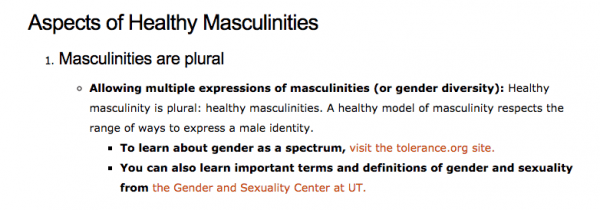Texans Vs. ‘Restrictive Masculinity’

The University of Texas in Austin is going to treat masculinity as a health problem. No, really. In Texas. Excerpts from the university’s announcement:
MasculinUT recognizes unhealthy masculinity as restrictive and exclusionary in the sense that it only affords a narrow definition of what it means to be masculine. This definition of masculinity also restricts what is acceptable in terms of appearance. This also makes it exclusionary, because a restrictive definition of masculinity depends on excluding people from that definition. Students who do not feel what a “real man” should feel, think the way a “real man” thinks, or looks the way a “real man” is supposed to look are vulnerable to violence from others who cannot accept male students who stray from this narrow definition. Students who feel targeted are also at risk of engaging in violent behavior in an attempt to not be the target of violence. Restricting the definition of masculinity can turn students into “pressure cookers,” where if a student is not allowed to express all of their emotions and thoughts, these just build up and can explode in various, unhealthy ways (such as violent behavior or coping mechanisms such as drinking).
If you are a male student at UT reading this right now, we hope that learning about this helps you not to feel guilty about having participated in these definitions of masculinity, and instead feel empowered to break the cycle!
More:
Patterns of Restrictive Masculinity
-
Restrictive masculinity is taken for granted and is often expected of male and male-identified students. The harm that this can cause to the self (such as high-risk drinking or reluctance to seek out help) and harm against others (such as sexual harassment, sexual assault and other forms of abuse and violence) is often ignored or condoned by believing that “boys will be boys.”
-
Unhealthy masculinity can restrict the emotional development of students, yet recognizes aggression and violence as common and normalized behavior for men.
-
Unhealthy masculinity works by excluding students who are judged not to measure up to the values of “real men.” This is especially pronounced in the exclusion of feminine gender expressions, gay, bisexual and queer men, and gender-expansive students, which perpetuates sexism, homophobia, biphobia and transphobia.
-
To prove who is a “real man” means proving who is not a “real man.” This can take the shape of competition between men, which often results in devaluing and/or hurting some men in order to appear more masculine. If unhealthy masculinity is not questioned, it could lead to racist, classist, ableist, and other violent behavior to devalue other students in the competition to prove who is a “real man.”
-
Unhealthy masculinity works to exclude any “femininity” from a masculine identity. This can create challenges when students want to have relationships on campus (platonic or romantic). A lack of empathy and a devaluation of femininity can result in unhealthy behavior and risks the occurrence of relationship and sexual violence. It also perpetuates the exclusion of women from academic and extracurricular activities.
Yadda-yadda-yadda-genderqueer-yadda-yadda. More:
The lesson to learn from the above graphic is that who you are attracted to is not dictated by your biological sex or by your gender expressions. Likewise, the type of body you are born with does not dictate your gender expression, or set your gender expression in stone. Someone defined at birth as “male” may act in feminine ways and be attracted to masculine women. Someone defined at birth as “female” may express a very masculine gender identity and be attracted to women. Gender expression and sexuality can vary in a student’s life. In other words, at different points in their life, students may identify as straight, queer, bisexual, masculine, feminine, etc. Students should not feel pressured to restrict their gender identity, sexuality, gender expression, or any part of whom they are if they don’t want to.
With that in mind, on this page we offer some guidelines for men who want to take more control over their gender identity and develop a healthy sense of masculinity.
Sure, if by “take more control,” you mean “surrender your sanity to ideologues and other crazy people.” Under no circumstances should you trust the kind of people who come up with documents like this to define “healthy sense of masculinity.”

They’re pathologizing ordinary manhood. I’m with this guy’s judgment on the program:
It’s difficult to comment on this without cursing violently so I won’t.https://t.co/xN8AWnXWWo
— Jordan B Peterson (@jordanbpeterson) April 30, 2018
https://platform.twitter.com/widgets.js
This. Is. Happening. In. Texas. Save us, Beavis and Butt-head!
[youtube https://www.youtube.com/watch?v=JTVzSq81wCs]
Subscribe for as little as $5/mo to start commenting on Rod’s blog.